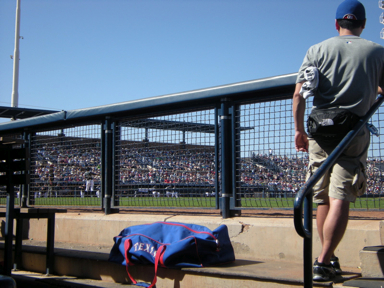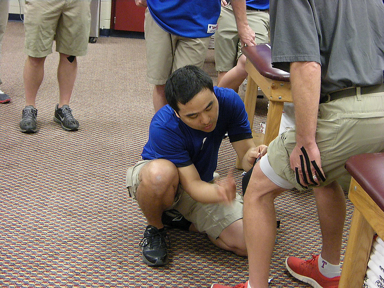MLB Arizona spring camp:
Trainers internship program
It was a rare and great opportunity for me to join the MLB spring camp in Arizona. This MLB internship training program was designed to deepen the relationship of health care practitioners, specifically for athletic trainers that were involved with baseball in Japan and the U.S. Japanese Baseball Athletic Trainers (JBATS) and Professional Baseball Athletic Trainers Society (PBATS) who organized this program. Since I graduated medical school in 2002, I would have never imagined that I would join the MLB internship training. When I got a call that I was selected to join the program, I was worried because I did not know much about baseball and I turned 40 years old. I have played sports, but I have been reading medical textbooks and studying methods to assist patients’ healing for the last 10+ years. Because in Japan, trainers for professional baseball teams are not only athletic trainers, I was able to qualify for this program. I thought the experience at the MLB spring camp would deepen my skills to treat not only athletes but also regular patients, and would also benefit my students at Bastyr University.
During spring camp, my schedule started by waking up 4:30 a.m. and going to the Seattle Mariners training room by 4:50 a.m. We had a total of five interns including myself (one from Japan who was in a physical therapy program, two athletic trainer students who were in bachelor programs, and one athletic trainer student who was in a master program). We helped to prepare Mariners trainers for a busy day by making cold packs, preparing for hydrotherapy tubs, and organizing materials. After preparing, we had exercise training for trainers. The Mariners Fitness strengthening and conditioning coach trained us with various strengthening exercises. Since I would be working with the Rangers, I had to leave before the exercise training ended and I had to do extra runs. I personally thought that the Mariners strengthening and conditioning coach did not like the fact that I was working with the Rangers. After exercise training, I would start working with Rangers players by 6:30 a.m.
I was introduced to all the trainers on the first day and observed the service that they provide to the players. I learned a lot by observing all the trainers. Athletic trainers were the first contact to players and worked with team physicians. I was impressed by the knowledge and skills of the Rangers athletic trainers. On my second day of this program, I was fortunate to be asked to work with one of the lineup pitchers that I did not know well. I was a bad student because I did not study all the players. This pitcher noted that he felt a little sore on his anterior shoulder. Upon palpation I was sure that he had bicipital tendinitis, so I worked on the bicipital tendon and did myofascial release like I would treat my patients in Seattle at my primary care practice. The mistake I made was that I didn’t know there were training schedules for all the players and their medical histories. I knew he would get a sore shoulder from the treatment, which I should have avoided because he was supposed to practice pitching the next day. I felt really bad and quickly learned on the third day of training that I needed to study more about the players and also needed to understand their bodies even though his shoulder was fine in a few days. Since this mistake, I listened to each player’s body before I even started stretching.
Once I paid attention more carefully, I quickly noticed the differences of tissues from the patients that I usually saw at my primary care practice or Bastyr University clinic. I have worked with several top athletes before; however, the Rangers players’ tissues were fascinating. For example, one of the top hitters asked me to manipulate his ankle. After assessing, I did not want to perform High Velocity Low Amplitude (HVLA) manipulation. I felt the ligaments of the ankle were loose and would not be good to manipulate even though I found restrictions at the subtalar joint and ankle mortise joints. I did Muscle Energy Stretch (MES) instead and mobilized the joints, but the player was not satisfied and insisted that I manipulate his ankle. So I applied Kinesio taping to support the soft tissue, especially the anterior and posterior talofibular ligaments and the calcaneo-fibular ligament, and manipulated. The player was satisfied but his ankle swelled up the next day. This was my second mistake. I felt so bad again that I did not want to touch those million dollar players anymore. I talked with one of the trainers and he taught me that we needed to really understand how these players’ bodies worked. He also told me not to worry too much about the swollen ankle of this top hitter and to wait one day to see what would happen to his ankle. So I applied Kinesio Fan cut tape to his swollen ankle to facilitate drainage of the swelling and waited a day. The next day this top hitter came in and I was surprised because most of the swelling was gone. It usually would take 4-5 days for these swellings to go down especially when a patient continues with daily living activities. I was blown away by his healing power.
I literally felt that I had made a huge mistake, but I probably manipulated the restrictions of his ankle joints and allowed healing and assisted the body to form stronger soft tissue and joints. Every day I was amazed by all the players and trainers. Every day was learning for me. I soaked up as much as I could. I learned about strengthening exercises, PNF, specific stretching, warm-up for different players, Class IV laser, compression machine, and more. Most importantly, I was impressed by who the trainers were. Each Rangers trainer demonstrated integrity and respect toward other workers at camp and players. I also learned how hard those players work. I should not say that I understood how hard players worked, but I understand a little. I felt that I was on trial. I felt if players liked how I treated/worked with them, they would ask me again, but if I did not do a good job, they would not ask me again. I felt that I had to do more than my best. I was under a tremendous amount of pressure that I have not felt for a while. I felt I was representing all the organizations and people that supported me to be there.
I am not sure if I would be able to do this training again, but for sure I would love to if I have another opportunity. I learned so much and I’d like to thank Texas Rangers practitioners, Jamie Reed ATC, Head Athletic Trainer/Medical Director Kevin Harmon ATC, Assistant Athletic Trainer Matt Lucero ATC, Assistant Athletic Trainers, and Massage Therapist Ralu ——-. I learned so much from them. I also want to show my appreciation to organizers of this program: President of JBATS Mr. Kawashima, JBATS assistant Mr. Kono, and PBATS organizer Rick Griffen ATC, Head Athletic Trainer of the Seattle Mariners.
Finally, I would like to thank Dr. Dean Neary, Chair of the Physical Medicine department at Bastyr University and Dr. Jane Guiltinan, Dean of the Naturopathic Program at Bastyr University to allow me to work outside the University and share the medicine and also Dr. Kenzo Kase who taught me the principles and methods to treat athletes and patients and supported me to join this training program. I am really excited now to utilize what I have gained at this training for my patients and athletes and also to share the knowledge and skills with students at Bastyr University.








